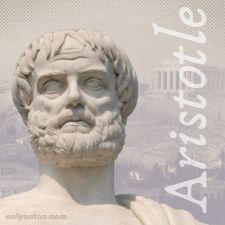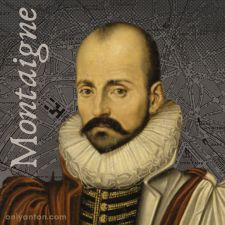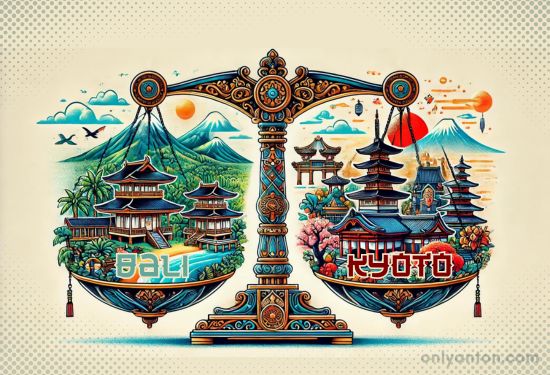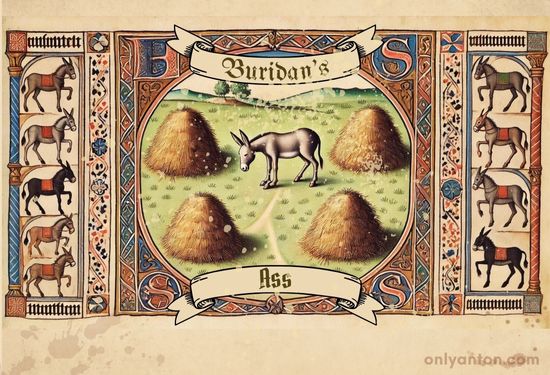Part 3 of the Navigating Decisions: Mindful Travel and Intentional Living series
Introduction
Imagine standing at a crossroads, each path leading to an equally enticing destination, yet you find yourself unable to choose. This indecision dilemma encapsulates a common struggle that many face, particularly when planning travel: indecision. Whether choosing between two dream destinations or deciding on the best activities to fill your itinerary, the paralysis of indecision can turn an exciting adventure into a stressful ordeal.
To shed light on this dilemma, let’s delve into the thought experiment of Buridan’s Ass. This philosophical conundrum, originating from the 14th-century French philosopher Jean Buridan, illustrates the perils of indecision. The thought experiment involves a hypothetical donkey placed exactly midway between two identical piles of hay. Unable to choose between the two, the donkey starves to death, paralyzed by indecision. This paradox is a powerful metaphor for the challenges we face when stuck between equally appealing options.
In this blog post, we will explore how this thought experiment can provide valuable insights into overcoming travel indecision and making mindful choices. By examining the interplay of passion, motive, and reason, we’ll uncover strategies to help you make confident and fulfilling travel decisions.
This post is part of the “Navigating Decisions: Mindful Travel and Intentional Living” series. Building on previous discussions in “Passion and Mindful Travel” and “Understanding Descartes’ Error: Embracing Emotion in Mindful Travel,” we’ll continue to explore how understanding the connection between emotion and rationality can lead to more intentional travel experiences. Join me as we navigate through the lessons of Buridan’s Ass to transform indecision into decisive, mindful travel adventures.
Understanding Buridan’s Ass
Definition and Origins of Buridan’s Ass
The thought experiment known as “Buridan’s Ass” is attributed to the 14th-century French philosopher Jean Buridan. Buridan himself did not explicitly frame the dilemma with an ass choosing between two piles of hay. However, his philosophical exploration of indecision has been famously satirized in this way. Buridan’s original statement was: “Should two courses be judged equal, then the will cannot break the deadlock; all it can do is to suspend judgement until the circumstances change, and the right course of action is clear.” This thought experiment illustrates the dilemma of indecision when faced with equally compelling options.
In the thought experiment, a hypothetical donkey (or ass) occupies a position precisely midway between two identical piles of hay. Each pile is equally desirable and equidistant, presenting no apparent reason to choose one over the other. Paralyzed by indecision, the donkey starves to death, unable to decide. This scenario, though exaggerated, underscores the difficulties that can arise when making decisions between seemingly equal alternatives.
Broader Philosophical and Historical Context
The concept of indecision in the face of equally attractive choices is not unique to Buridan. Several philosophers across history have presented similar scenarios:

1. Aristotle (384-322 BCE): Aristotle described a situation in which a man, equally hungry and thirsty and equidistant from food and drink, remains immobile due to indecision. This early exploration emphasizes the challenge of choosing when no option outweighs the other.
2. Al-Ghazali (1058-1111): The Arabic philosopher Al-Ghazali discussed a scenario in which a man desires two identical dates but can only take one. This example highlights the intrinsic quality within the individual that eventually prompts a choice despite the equality of options.

3. Michel de Montaigne (1533-92): Montaigne doubted the plausibility of such a dilemma but acknowledged its dire consequences. He noted that if two necessities were equally appealling to a person, the person might perish from inaction.

4. Baruch Spinoza (1632-77): Baruch Spinoza, in his Ethics, discussed a similar scenario, conceding that a person in perfect equilibrium might die of hunger and thirst. He questioned whether such a person should be considered more akin to an ass than to a human.

5. Gottfried Leibniz (1646-1716): Gottfried Wilhelm Leibniz, known for his Principle of Sufficient Reason, doubted the real-world occurrence of such indecision but admitted that, if possible, the ass would starve to death.

6. Jean-Paul Sartre (1905-80): The existentialist Jean-Paul Sartre offered a more modern example. He describes of a young man who must choose between joining the French resistance and caring for his mother. Despite the apparent differences between these choices, the young man remains paralyzed by indecision, illustrating the complex interplay of emotional and rational factors.
Mundane Example: Supermarket Shopping
A more relatable example involves shopping in a supermarket. Faced with rows and rows of similar products, say cans of soup, one is tasked with choosing one. Even after eliminating less accessible cans and any that are damaged, one may still face at least two cans that are not discernibly different from each other, providing no rational basis for choosing one over the other. This common scenario highlights the relevance of the dilemma in everyday life.

Relevant Example: Mindful Travel Decisions
Consider a scenario where a traveller must choose between two equally appealing destinations: a serene beach retreat in Bali and a cultural tour through Kyoto. Both options offer unique experiences and have equal appeal based on the traveller’s interests in relaxation and cultural immersion. The dilemma mirrors Buridan’s Ass: faced with two equally attractive options, the traveller struggles to make a decision. Without a clear preference, the traveller might remain indecisive, potentially missing out on booking flights or accommodations before they become unavailable or more expensive. This indecision can lead to increased stress and a less enjoyable planning process.

Key Elements of the Thought Experiment
Equilibrium of Choices: The thought experiment hinges on the (subjectively perceived) equilibrium of choices, where two options are equally desirable and equidistant. This balance creates a scenario where rational decision-making is insufficient to break the deadlock.
Indecision: The central paradox arises from the inability to choose between the two options. The ass, representing the decision-maker, finds no rational basis to prefer one pile of hay over the other, leading to a state of indecision.
Consequences of Inaction: The dire result of this indecision is starvation. The thought experiment starkly illustrates the potential outcome of failing to act when faced with equally compelling alternatives. While the scenario is hypothetical and exaggerated, it underscores the importance of making decisions, even when the options appear equally attractive.
Implications for Decision-Making
The thought experiment of Buridan’s Ass highlights the challenges of making choices when faced with equally appealing options. It demonstrates the limitations of purely rational decision-making and underscores the necessity of incorporating other factors, such as emotions, intuition, and practical considerations, into the decision-making process. This dilemma is particularly relevant when decisions must be made promptly and decisively, such as in travel planning, where delays or indecision can lead to missed opportunities and increased stress.
Understanding Buridan’s Ass and its broader philosophical implications can provide valuable insights into the nature of decision-making. Individuals should recognize the importance of balancing rational analysis with other motivating factors. Doing so may help them to overcome indecision and make more mindful and intentional choices.
Passion, Motive, and Reasons for Action
Catalysts for Action
Passion and emotion are potent catalysts for action. When faced with indecision, especially in travel planning, our emotions can push us to break the deadlock. Emotions such as urgency, excitement, or fear can drive us to choose, even when our rational mind struggles to find a clear preference.
For example, consider the urgency of a limited-time travel offer. The excitement of an impending adventure can compel us to decide quickly to secure the opportunity. Similarly, the fear of missing out (FoMo) can push us to choose a destination that promises unique experiences we may not have the chance to enjoy again. Emotions add a layer of immediacy and importance to our decisions, which purely rational considerations might only sometimes provide.
Passion, in particular, can be a significant motivator. Passionate travellers often have strong emotional connections to certain places or activities, which guide their choices. Whether it’s the allure of exploring ancient ruins, the joy of immersing in a new culture, or the thrill of an adrenaline-pumping adventure, passion can steer us toward decisions that align with our deepest desires and bring us the most fulfillment.
Motives and Intentions
Having clear motives and intentions is crucial in guiding travel decisions. When we understand our deeper motivations, we can prioritize our options more effectively and make choices that resonate with our core values and interests. Here are some examples of common travel motivations:
1. Adventure: For those driven by a sense of adventure, destinations that offer thrilling activities like hiking, diving, or exploring remote locations may take precedence. The excitement of pushing personal boundaries and experiencing the unknown can make these options particularly appealing.
2. Relaxation: Travelers seeking relaxation might prioritize destinations known for their serene environments, luxury resorts, or wellness retreats. The primary motive here is to unwind, de-stress, and rejuvenate, making such places ideal for achieving these goals.
3. Cultural Immersion: Cultural enthusiasts often look for destinations rich in history, traditions, and local customs. The desire to learn about and experience different cultures firsthand can guide them to places with vibrant cultural scenes, historical landmarks, and authentic local experiences.
4. Personal Growth: For some, travel is a means of personal development and self-discovery. Destinations that offer opportunities for learning, volunteering, or engaging in transformative experiences can be particularly attractive.
By identifying and understanding these underlying motivations, travellers can make more intentional and satisfying decisions. For example, someone with a strong interest in cultural immersion might choose a destination with a rich cultural heritage over a beach resort, even if both options are equally appealing in other respects.
In travel planning, balancing rational considerations (such as budget, time, and logistics) with emotional and passionate desires (such as curiosity, excitement, and personal connection) leads to more fulfilling experiences. Recognizing the interplay between these factors helps avoid the paralysis of indecision and ensures that our travel choices align with our true aspirations and values.

Applying the Concept to Mindful Travel
Balancing Rationality and Emotion
In mindful travel, balancing rational considerations with emotional desires is essential. Rationality involves practical aspects such as budget, time, and logistics, ensuring the trip is feasible and well-planned. However, purely rational planning can sometimes overlook the emotional and passionate elements that make travel deeply fulfilling and transformative.
Rational Considerations:
- Budget: Ensuring that the trip is affordable and aligns with financial constraints.
- Time: Planning the duration of the trip to fit within personal or professional schedules.
- Logistics: Coordinating travel arrangements, accommodations, and activities to ensure a smooth experience.
Emotional Desires:
- Curiosity: The drive to explore new places, cultures, and experiences.
- Excitement: The thrill and anticipation of new adventures and discoveries.
- Personal Connection: The emotional ties to particular destinations, whether through heritage, previous experiences, or personal interests.
Mindful travel involves integrating these rational and emotional elements to make decisions that align with personal values and intentions. By considering both the practical and the passionate aspects of travel, individuals can create experiences that are not only efficient but also deeply meaningful.
Avoiding Indecision in Travel Planning
Indecision in travel planning often arises from too many appealing options and insufficient clarity on what truly matters. To avoid this problem, setting clear priorities and reflecting on personal motivations and goals is essential. Here are some strategies to help make confident decisions:
1. Set Clear Priorities
Identify the most important aspects of the trip. Is the goal to relax and unwind, to seek adventure, or to immerse yourself in a new culture? By understanding the trip’s primary purpose, you can narrow down choices that best align with your priorities.
Example: If relaxation is the priority, consider destinations known for their serene environments and wellness retreats. If cultural immersion is the goal, look for places with rich historical backgrounds and vibrant local traditions.
2. Reflect on Emotional States
Consider your current emotional state and what you hope to achieve through travel. Are you feeling stressed and in need of a peaceful escape, or are you seeking excitement and new experiences?
Example: If you are feeling burnt out from work, a quiet beach resort or a mountain retreat might be more appealing than a bustling city adventure.
3. Align with Long-Term Goals
Think about your long-term travel goals and how this trip fits into them. Are you working towards visiting all the wonders of the world, exploring a particular region, or gaining a deeper understanding of different cultures?
Example: If you have a long-term goal of exploring Asian cultures, choosing a destination like Japan or Thailand can contribute to that broader objective.
4. Use Decision-Making Tools
Employ tools such as pros and cons lists, decision matrices, or even mind maps to organize your thoughts and evaluate options systematically. These tools can help visualize the choices and clarify which option best aligns with your intentions.
Example: Create a decision matrix with factors such as cost, travel time, cultural experiences, and personal interest, then rate each potential destination to see which scores highest overall.
5. Rely on Random Chance
In cases where indecision persists, embrace a bit of randomness to help make a choice. Trust in luck by flipping a coin for a binary decision or writing down multiple options on small pieces of paper and drawing one at random from a hat or bowl. This approach can inject some fun into the decision-making process and reveal your true preferences through your reactions to the outcomes.
Example: Flip a coin to choose between two destinations. If there are more options, write each destination on a piece of paper, place them in a hat, and draw one. If you feel disappointment or hope for a specific outcome while drawing, use that insight to guide your final decision, as it indicates a hidden preference.
By implementing these strategies, travellers can overcome the paralysis of indecision and make choices that are both rational and emotionally satisfying. Mindful travel is about making intentional decisions that resonate with personal values and desires, leading to more enriching and memorable experiences.
Conclusion
In this blog post, we have explored the intricate dynamics of decision-making through the lens of Buridan’s Ass. This thought experiment highlights the challenges of indecision when faced with equally appealing options. Here’s a recap of the key points discussed:
Understanding Buridan’s Ass:
We delved into the origins and philosophical context of Buridan’s Ass, illustrating the paradox of indecision when confronted with two equally desirable choices. By examining this thought experiment and similar scenarios from other philosophers, we highlighted the essential elements: equilibrium of choices, indecision, and the consequences of inaction.
Passion, Motive, and Reasons for Action:
We discussed how emotions and passions can catalyze action, breaking the deadlock of indecision. By understanding and leveraging our deeper motivations—such as the desire for adventure, relaxation, or cultural immersion—we can prioritize options and make more decisive travel choices.
Applying the Concept to Mindful Travel:
Emphasizing the need to balance rational considerations with emotional desires, we explored how mindful travel involves aligning decisions with personal values and intentions. By setting clear priorities and reflecting on emotional states or long-term goals, travellers can avoid indecision and make more confident choices.
Final Thoughts
Understanding and integrating both passion and rationality in travel decision-making is crucial for creating intentional and fulfilling experiences. By recognizing the role of emotions and leveraging them alongside rational analysis, we can navigate the complexities of choice with greater clarity and purpose.
As you plan your travels, embrace your passions and allow them to guide your decisions. Trust your instincts, set clear intentions, and be mindful of your emotional responses. By doing so, you can make choices that meet practical needs and resonate deeply with your values and desires.
What About You?
I would love to hear your thoughts and experiences related to indecision in travel planning. Have you ever found yourself stuck between two equally appealing travel options? How did you overcome the indecision? Share your stories and tips in the comments below.
Stay tuned for the next blog post in the Navigating Decisions: Mindful Travel and Intentional Living series. I will delve into the topic of overcoming overthinking with practical strategies to conquer paralysis by analysis. Subscribe to the newsletter to stay updated on future posts and receive more tips on mindful travel and intentional living. Follow me on social media for daily inspiration and exclusive content.
Further Reading and Resources
Related Blog Posts on Only Anton:
- Passion and Mindful Travel: Part One of the Navigating Decisions: Mindful Travel and Intentional Living series. Discover the role of passion and emotion in travel decisions. Transform your travel experiences with mindfulness and intention.
- Understanding Descartes’ Error: Embracing Emotion in Mindful Travel: Part Two of the Navigating Decisions: Mindful Travel and Intentional Living series explores the role of emotions in mindful travel through Antonio Damasio’s insights. It explains how integrating emotions can enhance travel experiences and decisions.
- Travel and Philosophy: Discover how the connections between travel and philosophy can inform our journeys and give us mindful insights into cultures.
- Mindful Travel: Explore mindful travel: aligning intentions with experiences, avoiding overplanning, and embracing spontaneity for a meaningful journey.
Books:
- Descartes’ Error: Emotion, Reason, and the Human Brain, by Antonio Damasio: This book explores the critical role of emotions in decision-making and challenges the traditional mind-body dualism. Damasio presents the somatic marker hypothesis, demonstrating how emotional processes are integral to rational thinking. Find it online, at a library, or buy it here.
- The Paradox of Choice: Why More Is Less, by Barry Schwartz: Schwartz examines how the abundance of choices in modern life can lead to anxiety and indecision. He argues for the concept of “satisficing” over maximizing to enhance well-being and satisfaction in decision-making. Read it online, at a library, or get your copy here.
Articles:
- “Buridan’s Ass,” Wikipedia: This article provides an overview of the thought experiment attributed to Jean Buridan, discussing its implications for decision-making and rationality. Read more here.
- “Why Buridan’s Ass Doesn’t Starve,” by Michael Hauskeller, Philosophy Now (2010): An accessible discussion of the Ass Paradox, examining its relevance and application in philosophical debates about free will, rationality, and decision-making. Read more here.
- “Understanding the Indecisive Mindset,” by Levi Riven, Psychology Today (January 2024): An article exploring indecision’s psychological roots and its impact on everyday life. Read more here.
Websites:
- Greater Good Magazine: Mindful Decision-Making: This resource delves into the benefits of mindfulness in making decisions, offering practical advice and insights into how mindfulness can improve clarity and reduce stress in decision-making processes. Read more here.
- Psychology Today: Decision-Making: A brief discussion of how to make good and avoid bad decisions. Find it here.




